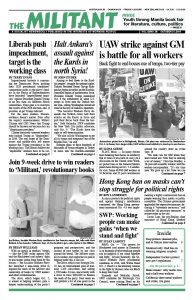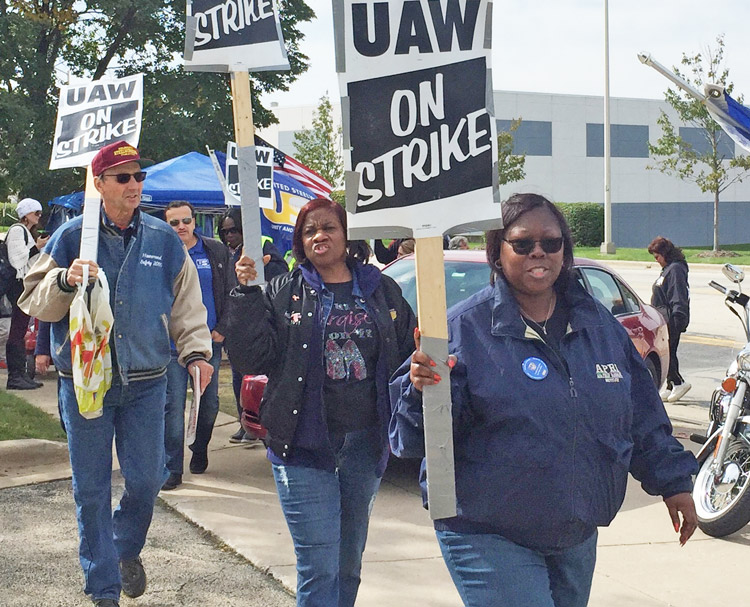FLINT, Mich. — So many drivers were honking their horns in solidarity that at times it was hard to carry on a discussion on the United Auto Workers picket lines at the General Motors plants here during an Oct. 5-6 solidarity visit. Some 49,000 GM workers at 33 factories and 22 parts warehouses around the country went on strike Sept. 16.
“We took cuts for GM when they were bailed out. Now they’re making a lot of money,” Christine Bradley, a 28-year-old assembly worker, told this worker-correspondent. “It’s our time now. We gave up a lot. Now we can get it back.”
Since 2007 the auto barons of the Big Three — General Motors, Ford, and Fiat Chrysler — have wrenched concessions from their workers. This accelerated with GM’s carefully preplanned 2009 bankruptcy — where the bosses dumped all the lines that weren’t turning enough profit — followed by the U.S. government’s multibillion-dollar “bailout.”
GM now pays new hires less money, just over half what “legacy” workers get, followed by an eight years “progression” that never gets you all the way equal. More than 7% of GM workers are now temps at even lower wages, who have no guarantee they’ll ever be hired on full time. And they’ve cut labor costs further by contracting out work and spinning off parts plants.
This paid off big time for GM bosses, who made $35 billion in profit over the last three years.
“I’ve never been on strike before,” assembly worker Bradley said. “You can feel the strength of solidarity. It gives me goosebumps. I decided I would come to the picket line every day even though we only have to picket four hours a week.”
Among the key issues in the strike are workers’ demands to make temporary workers permanent and “No more tiers.” Union officials are also demanding GM reopen or keep open four plants it plans to shutter.
There are thousands of GM “gypsies” who’ve had to move to new plants when theirs were shut down.
“They count on us temps,” Jessica Fields told the Militant. “We work six days a week, plus Sundays if the line is running. But we can’t ever call off. I called off one day because my father was dying, and my supervisor tried to write me up.”
They don’t get paid vacations, any kind of pension, not even a 401(k). They pay more for health insurance that covers less than permanent workers alongside them.
GM bosses keep on pressing
“Before the new plant was built in 2017, we made 36 doors an hour,” said body shop worker James Honea. “Now we build 50 an hour. The robots replaced workers, lifting the doors from station to station, and welding. Now we work two stations instead of one. It’s a lot of area to cover, walking back and forth. The robots eliminated the material drivers that supplied the line, but they hired 100 more temps to keep the line going at the speed they wanted.”
As a result, many workers have carpal tunnel, added Jane Stoffel, a permanent worker.
Among the strikers in Michigan and Ohio are 850 Aramark workers who are also members of the UAW.
“We make $8 to $9 less per hour than the GM skilled workers. And we’re all classified as janitors,” said Aramark pipefitter Bob Glass, who has worked at the GM plant for eight years, “even though there are about 35 skilled trades workers working for Aramark. ”
Aramark workers went on strike 24 hours before the GM workers. “The company threatened the other workers that they’d lose their jobs if they didn’t cross our picket line,” said Jeremiah Ball, an Aramark painter. “A few drove up in their trucks and turned around and went home because they didn’t want to scab on us. We’re members of the same UAW local. And now we’re on the same picket line, with the same struggle.”
GM says it needs more concessions to compete with its nonunion rivals in the U.S., including Toyota, Hyundai, Honda and Volkswagen.
With its bank accounts flush — GM is sitting on $17.5 billion in cash — the bosses are hoping to wear strikers down. They say they need to lower labor costs by $5 an hour or more by increasing the number of temps and making permanent workers pay more for health insurance.
In 1999, 83% of car assembly plants in the U.S were union. Today the figure is just 44%. Some 20% to 25% of workers at the nonunion plants are temps. In some plants as much as 40%. Many of those workers are watching the GM strike closely.
Many union officials have argued that the reason the Big Three’s competition is nonunion is because they are mostly located in the South, in so-called right-to-work states.
But both Michigan and Texas are also right-to-work states, where workers can legally opt out of joining the union. Autoworkers in both states are overwhelmingly in the union. Almost all of the workers at the GM plant in Arlington, Texas, are in the union. And the local there had one of the highest “yes” votes for a strike.
Government attack on union
GM bosses have gotten help in their attempt to undermine the strike. On Oct. 4, two former members of the UAW’s public relations departments, Rev. Peter Laarman and Frank Joyce, publicly demanded the entire UAW executive board resign because of federal Department of Labor agents’ accusations of corruption against UAW officials, including several indictments. Even though neither one has been part of the UAW in more than 15 years, their attack on the union in the midst of the strike got big play in the Detroit Free Press and the Detroit News.
The capitalist government’s intervention in union affairs is never good for working people. Only the union members themselves have the right to decide how to run their own affairs.
‘Strikes encourage you to stand up’
GM workers continue to win solidarity and morale is high on the picket lines.
Krista Brewer, who works at Horseshoe Casino in Baltimore, which is organized by the UAW, organized a trip Oct. 1 with two other casino workers and two retail workers from a nonunion Walmart in Landover, Maryland, to the picket line at the GM parts center in Martinsburg, West Virginia. They brought brownies, cases of water and 16 pizzas with them.
“The picket line is a good place if you are new to unions, to be part of something and feel welcome,” Brewer said.
Some strikers say they were inspired last year by the round of teachers strikes around the country. “I was very influenced by that,” striker Barry Burdue told the press at the picket line at GM’s Parma facility in Ohio, commenting on the West Virginia teachers strike. “I thought it was awesome that they walked.”
“I hope our strike encourages other places to stand up,” he said.
One other group watching carefully are UAW members at Ford and Fiat Chrysler — their contracts are temporarily extended until after the GM workers contract has been ratified.
Amy Husk from Louisville, Kentucky; Dan Fein from Chicago; and Arlene Rubinstein from Washington, D.C., contributed to this article.


